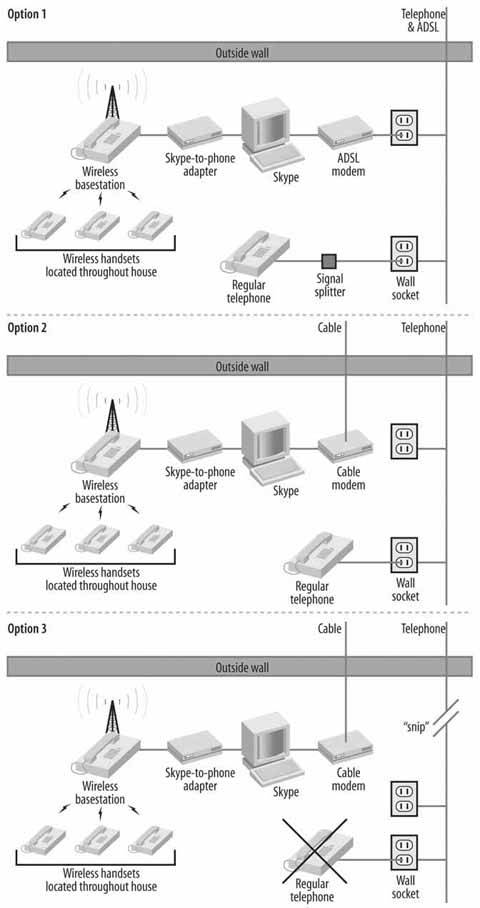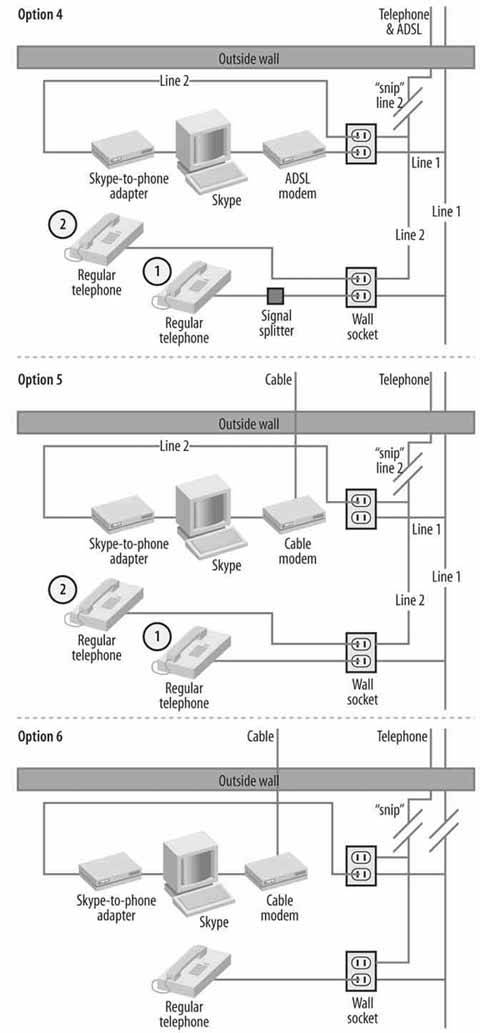Hack30.Configure Skype to Use Regular Phones
Hack 30. Configure Skype to Use Regular Phones
By making your existing phones work with Skype, you not only eliminate the expense of buying new ones, but you also end up with a phone system that largely looks and feels the same as before. Works with: Windows and Linux versions of Skype. Connecting your existing phones to Skype is easy. Using this hack, you can hack around with your existing phone system in a variety of interesting ways, from simply having the convenience and familiarity of a regular phone next to your computer for making and receiving Skype calls, to driving all the existing copper wiring throughout your house using Skype in what is basically a replacement of your regular phone service. If all this sounds somewhat daunting, don't worry, as even the most advanced hacking requires little more than a pair of wire cutters, a roll of electrical insulation tape, and a little common sense! Configuring Skype to work with a regular phone requires a Skype-to-phone adapter box, shown in Figure 3-10, and some associated software. Skype-to-phone adapter boxes cost $50 or less (though more-expensive and feature-rich units are hitting the market as I write) and are interfaced through and sometimes powered by your computer's USB interface. Figure 3-10. Skype-to-phone adapter, front and back Normally, getting a Skype-to-phone adapter up and working is simplicity itself. Plug one end of a USB cable into the back of the adapter, and the other end into an available USB port on your computer. Install the software and drivers, give the new software access to Skype (Skype will prompt you to give your permission), and then simply plug a regular phone into the adapter using an RJ11 connector. If you want to be able to switch between a regular phone line and Skype, there's usually a "line" socket on the adapter that you can connect to a phone socket in the wall using a regular RJ11 cable (RJ11 plugs on both ends). Double-check that your Skype sound-in and sound-out devices are set to your new adapter (Skype
Options for configuring Skype with regular phones run the whole gamut from simply using a regular phone handset while sitting at your computer, to driving your home phone system with Skype (see Figure 3-11). Look at the available choices and how you would like to use Skype with your existing phone infrastructure. And, as perhaps a key part of your decision making, consider how much money you want to shave off your current phone bill. Characteristically, the more you do with Skype and the less you use the services of your regular phone company, the more money you can save. Lastly, bear in mind that Figure 3-11 and Figure 3-13 merely show some of the configuration options you might want to try; don't be afraid to experiment and let your imagination run free, as Skype and its underlying technologies are almost begging to be hacked! The first thing to notice about the options illustrated in Figure 3-11 and Figure 3-12 is that you can completely convert your existing phone infrastructure to Skype only if you obtain your broadband Internet connection through cable or something other than DSL. Here are the relative merits of the configuration options:
Adapting your existing phone infrastructure to work with Skype, in whole or only in part, can be a challenge. But then again, the payoff can make the effort worthwhile. Indeed, with a little planning, some small expenditures on new equipment (which you recoup through your savings within a matter of months), and a willingness to experiment, you can in large measure replicate your existing phone system and services, but at a fraction of what you pay now. I describe my Skype phone system in "Build a Skype Server" [Hack #35]; my estimated savings using this system are a little shy of $700 per year. That's $700 this year, next year, the year after that, and in subsequent yearsbig savings! Moreover, with a little ingenuity, there are workarounds for most of Skype's 'limitations"911, 411, fax, and so forthand I present these workarounds as hacks in Chapter 10. So, pick a configuration option and get hacking! (And saving!) |
EAN: 2147483647
Pages: 168
 Tools
Tools  Options …
Options … 

